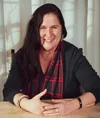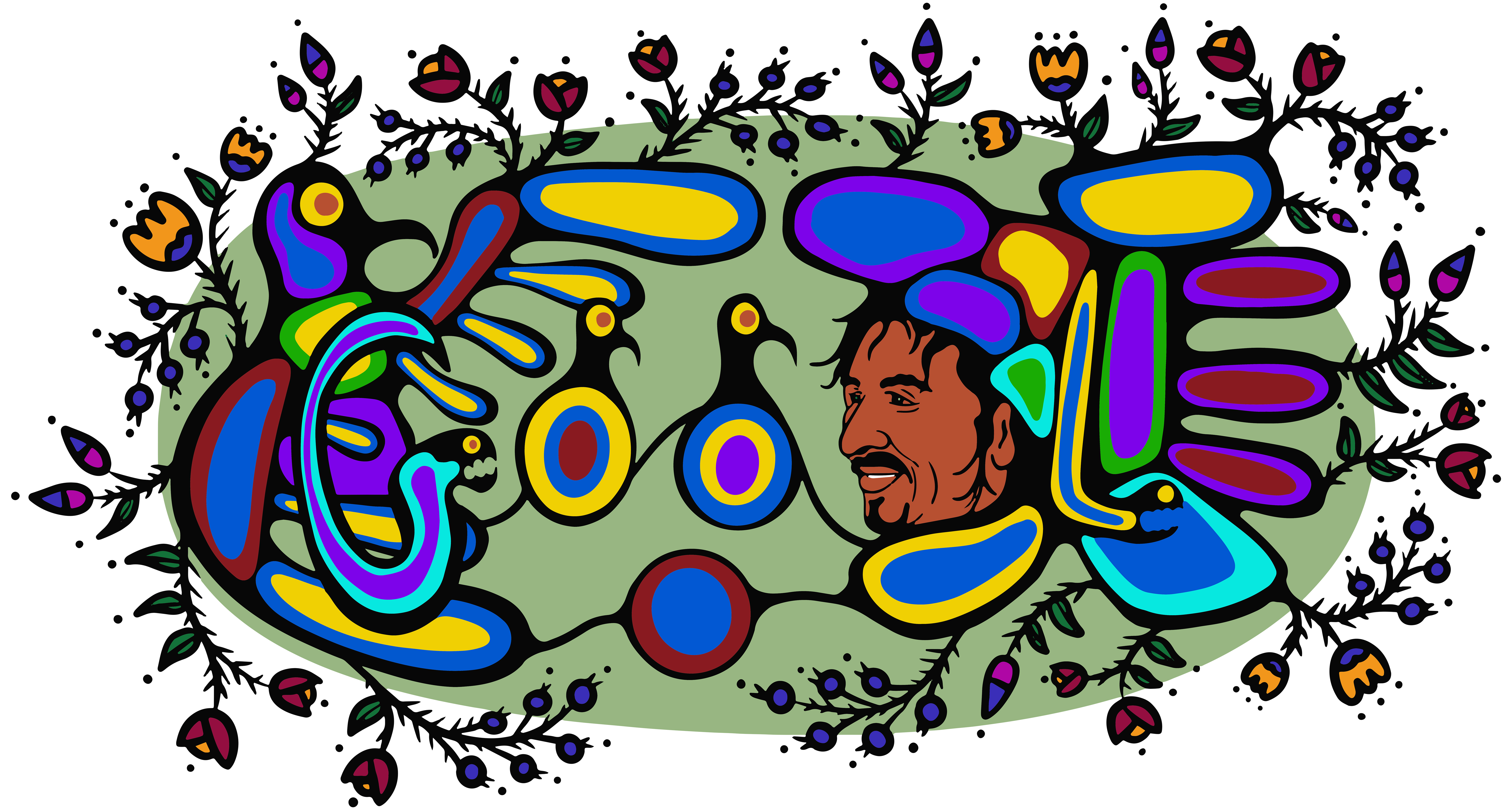Aquaquli: What about tomorrow? Remembering Mitiarjuk Nappaaluk

Editor's Note: This blog post was guest written by Dr. Norma Dunning, a Padlei Inuk writer, and professor based in Edmonton, Alberta. Today, the Google Doodle on the Search homepage in Canada honours Mitiarjuk Nappaaluk (1931-2007), a notable Inuit author, teacher and historian, best known for her novel Sanaaq, one of the first Inuktitut-language novels. The Google Doodle was created by Inuit artist Gayle Uyagaqi Kabloona. Learn more about the life and legacy of Mitiarjuk Nappaaluk as written by Dr. Dunning below.
When I was asked to write about Mitiarjuk Nappaaluk, I found myself thinking: if someone wrote an article about my mom, what would I want the writer to say?
Unlike Nappaaluk, my Inuk anaana (mother) did not write books or sculpt art out of stone. She didn’t win awards or help document Inuktitut language, or Inuit traditions like hunting practices and birthing songs. My anaana and Nappaaluk were born within a few years of each other and their lives took very different paths. Each path brought them to a different part of Canada, but they faced similar challenges wrestling with the ways of the kabloona (whitemen).
I often find myself wondering what would have happened to my anaana and to Nappaaluk if colonization hadn’t changed their lives. It has become a fantasy for me. I dream of the lives of my ancestors without the interruptions of by non-Inuit who may have had good intentions that often resulted in harm. I have been re-reading the last chapters of Sanaaq, Nappaaluk’s most well-known novel and the first written in Inuktitut syllabic, and find myself trying to understand how things were interpreted by her.
The novel tells the story of Sanaaq, a widow and her semi-nomadic Inuit family, as they conduct their day-to-day activities living off the land, while responding to the changes brought on by the Qallunaat (Euro-Canadians). In chapter 45, Nappaaluk writes about the community’s first medical examinations. She writes of the pain felt by the needle used for a blood test and gives the exact weight of each of the family members in the story. When I read this, I knew it was about tuberculosis testing in the 1950s and the movement en masse of approximately 5,000 Inuit into twenty-one southern sanitoriums. I wondered what a blood test would have meant to an Inuk or how knowing their weight changed their perceptions of self and one another.
Back then, Inuit would not have thought about obesity as harmful, instead it would have represented health and prosperity. Our ancestors lived very active lives and it was only when foreign foods entered the picture that their bodies obviously changed. Colonization through food is not given enough thought. Sugar, salt, flour, coffee, tea, alcohol and tobacco never used to exist in the Inuit diet and are each highly addictive.
On page 189 of Sanaaq, Nappaaluk writes, “Angutikallak! You will not eat seal blubber too often. You are too fat for someone as young as you!” That sentence shows the diversion from non-Inuit medicine, and the villainization of food that once sustained Inuit life. This mother had likely not perceived her child as overweight before the foreign nurse arrived in their community, but here Nappaaluk highlights the subtleties of colonial influence.
In Sanaaq, Nappaaluk also gives us a glimpse of Inuit marriage customs. Traditionally, Inuit would promise their children in marriage when they were very young, and as they grew they would call each other, “Uik” (husband) and “Nuliaq” (wife). Slowly they would learn to care for each other. He would bring her his first hunting kill, and help supply meat to her family. She would begin to sew his clothing and boots. As they matured, they would learn more about each other, like her favourite food, the dimensions of his hands and feet, and the personalities of the families they would marry into. While these customs may seem foreign to us today, in truth there is boundless beauty in a lifelong courtship.
In the novel, we learn that Arnatuinnaq, Sanaaq’s older sister, is carrying the chief factor’s baby, a white man who has been running the trading post. But Anatuinnaq had been promised to an Inuit man, and Nappaaluk writes of the shock felt by the community when they discover her secret. What Nappaaluk crafts within three paragraphs (page 189 & 190) is an epiphany about the undoing of Inuit culture. She writes, “The Inuit realized for the first time that some unpleasant things were being done to them,” through the invasion of non-Inuit medicine and the breakage of traditional marriage practices.
Nappaaluk, like many other Inuit, committed herself to preventing the erasure of Inuit culture and tradition. She chose to document Inuit culture through storytelling and sculpture-making, while others, like my anaana, lived their Inuit ways, quietly but profoundly.
They both lived through enormous change and learned to adjust to the world around them with grace and understanding and did their best to prepare their families for the future. Two women who gave deep thought to Aquaquli? (What about tomorrow?) and in doing so, left a legacy of Inuit-filled love.
About the author:
Dr. Norma Dunning is a Padlei Inuk writer, and professor. She writes fiction and non-fiction, prose and poetry. Her first work of nonfiction, Kinauvit? (What’s Your Name?) explains the Eskimo Identification Canada system (2022) and was a finalist for the Shaughnessy Cohen Prize for Political Writing with Writer’s Trust. Tainna (the unseen ones) received the Governor General's Award (2021). Annie Muktuk and Other Stories received the Danuta Gleed award (2018) and many other awards. Eskimo Pie: a Poetics of Inuit Identity and Akia: the Other Side are her poetic works. She lives in Edmonton.

ᐊᖁᐊᖁᓕ: ᖃᓄᐃᒻᒪᓪᓕ ᖃᐅᒃᐸᑦ? ᐃᖅᑲᐅᒪᓪᓗᒍ ᒥᑎᐊᕐᔪᒃ ᓇᑉᐹᓗᒃ
ᑎᑎᕋᖅᑑᑉ ᓇᓗᓇᐃᖅᓯᔾᔪᑎᖓ: ᐅᑯᐊ ᐅᓂᒃᑳᑦ ᓴᖅᑭᑕᐅᓚᐅᖅᑐᑦ ᐃᓇᑕᐅᓯᒪᓪᓗᓂ ᑎᑎᕋᓚᐅᖅᑐᖅ ᓘᒃᑖᖅ ᓄᐊᒪ ᑕᓂᖕ, ᐹᓪᓕᕐᒥᐅᑕᖅ ᐃᓄᒃ ᐅᓂᒃᑳᓂᒃ ᑎᑎᕋᖅᑎᐅᔪᖅ, ᐃᓕᓴᐃᔨᒻᒪᕆᐅᔪᖅ ᓄᓇᖃᖅᑐᖅ ᐃᐊᓐᒪᓐᑕᓐ, ᐃᐅᓪᐴᑕᒥ, ᐅᓪᓗᒥᐅᔪᖅ, ᒎᒐᐅᓪ ᑎᑎᕋᐅᔭᕐᕕᖓᓂ ᓴᖅᑭᔮᖅᑎᑕᐅᔪᖅ ᕿᓂᕐᕕᐅᑉ ᓇᔪᒐᖓᓂ ᑲᓇᑕ ᐅᐱᒍᓱᒍᑎᖃᖅᑎᓪᓗᒍ ᒥᑎᐊᕐᔪᒃ ᓇᑉᐹᓗᖕᒥᒃ (1931-2007), ᑖᓐᓇ ᐃᓄᒃ ᖃᐅᔨᒪᔭᐅᒻᒪᕆᒃᑐᖅ ᐅᓂᒃᑳᓕᐅᖅᑎᐅᓚᐅᕐᓂᖓᓂᒃ, ᐃᓕᓴᐃᔨᐅᓪᓗᓂ ᐊᒻᒪ ᐃᑦᑕᕐᓂᓴᕐᓂᒃ ᖃᐅᔨᒪᔨᑕᐅᓪᓗᓂ, ᐊᒻᒪ ᖃᐅᔨᒪᔭᐅᓂᖅᐹᕆᔾᔪᑎᒋᓪᓗᓂᐅᒃ ᐅᖃᓕᒫᒐᓕᐊᕆᓯᒪᔭᖓ ᑕᐃᔭᐅᔪᖅ ᓴᓈᖅ, ᑖᓐᓇ ᓯᕗᓪᓕᖅᐹᖑᓯᒪᔪᖅ ᐃᓄᒃᑎᑐᑦ ᐅᖃᐅᓯᕐᒥᒃ ᐊᑐᕐᓗᓂ ᐅᖃᓕᒫᒐᓕᐅᖅᑐᓂ. ᑖᒃᑯᐊ ᒎᒐᐅᓪ ᑎᑎᕋᐅᔭᕐᕕᖓᑦ ᓴᓇᔭᐅᓚᐅᖅᑐᖅ ᐃᓄᖕᒧᑦ ᑎᑎᕋᐅᔭᖅᑎᒧᑦ ᒐᐃᐅᓪ ᐅᔭᒐᕿ ᖃᑉᓗᓈᒧᑦ. ᖃᐅᔨᒋᐊᒃᑲᓐᓂᕈᒪᒍᕕᑦ ᐃᓅᓯᕆᓚᐅᖅᑕᖓᓂᒃ ᐊᒻᒪᓗ ᕿᒪᒃᓯᒪᔭᖏᓐᓂᒃ ᒥᑎᐊᕐᔪᒃ ᓇᑉᐹᓘᑉ ᐅᖃᓕᒫᕈᓐᓇᖅᐸᑎᑦ ᑎᑎᕋᖅᑕᐅᓯᒪᔪᑦ ᓘᒃᑖᖅ ᑕᓂᖕᒧᑦ ᐊᑖᓃᑦᑐᑦ.
ᐊᐱᕆᔭᐅᒐᒪ ᒥᑎᐊᕐᔪᒃ ᓇᑉᐹᓗᑉ ᒥᒃᓵᓄᑦ ᑎᑎᕋᖁᔭᐅᓪᓗᖓ, ᐃᒻᒥᓂᒃ ᐊᐱᖅᓱᓕᓚᐅᖅᑐᖓ: ᐊᓈᓇᒪ ᐃᓅᓯᖓ ᑎᑎᕋᖅᑕᐅᒃᐸᑦ, ᑭᓱᓂᒃ ᑎᑎᕋᕐᓗᖓ ᐅᖃᕈᒪᒐᔭᖅᐳᖓ?
ᐊᔾᔨᒋᓇᓂᐅᒃ ᓇᑉᐹᓘᑉ ᐊᓈᓇᒐᑕ, ᐃᓄᓪᓗᓂ ᐅᖃᓕᒫᒐᓕᐅᖅᑎᐅᓚᐅᕐᒪᓪᓕ ᑭᓯᐊᓂᓕ ᐊᓈᓇᒐ ᑎᑎᕋᖅᑎᐅᓚᐅᖏᑦᑐᖅ ᓴᓇᓐᖑᐊᖅᑎᐅᓚᐅᖏᑦᑐᕐᓗ ᐅᒃᑯᓯᒃᓴᓂᒃ. ᓵᓚᒃᓴᐅᓯᐊᖅᓯᒪᖏᑦᑐᖅ ᑭᓱᑐᐃᓐᓇᕐᓂᒃ ᐅᕝᕙᓘᓐᓃᑦ ᐃᓄᐃᑦ ᐅᖃᐅᓯᖏᓐᓂᒃ ᑎᑎᕋᖅᐸᓪᓕᐊᓚᐅᖏᑦᑐᖅ, ᐃᓕᖅᑯᓯᖏᓐᓂᒡᓗ ᐃᓄᐃᑦ ᐊᖑᓇᓱᒍᓯᖏᓐᓂᒃ ᐊᒻᒪ ᐃᕐᓂᓱᒃᓰᔪᑦ ᐃᒻᖏᐅᓯᖏᓐᓂᒃ. ᐊᓈᓇᒐ ᐊᒻᒪ ᓇᑉᐹᓗᒃ ᐃᓅᓚᐅᖅᓯᒪᔪᒃ ᐊᕐᕌᒍᓂᒃ ᐅᓄᖏᑦᑐᓂᒃ ᐊᖓᔪᒋᓪᓗᓂᐅᒃ ᐊᒻᒪ ᐃᓅᓯᖏᑦ ᐊᔾᔨᒌᖏᑦᑐᒧᑦ ᐃᖏᕋᓚᐅᖅᑑᒃ. ᐊᑐᓂᓗ ᐃᓅᓯᖏᓐᓂ ᐊᖅᑯᑎᒋᔭᖏᑦ ᐊᔾᔨᒌᖏᒃᑲᓗᐊᖅᑎᓪᓗᒋᑦ. ᐊᑐᓂ ᑭᓯᐊᓂ ᐃᓅᓯᖏᓐᓂᒃ ᓇᒡᓴᖅᓯᒪᓪᓗᑎᒃ ᑲᓇᑕᒥ ᓄᓇᖃᓕᓚᐅᖅᑑᒃ ᓄᓇᖅᑲᑎᒌᖕᓇᑎᒃ, ᑭᓯᐊᓂᓕ ᐊᒃᓱᕈᕐᓇᖅᑐᓂᒃ ᓵᓐᖓᒃᓯᖃᑦᑕᓚᐅᖅᑑᒃ ᐊᔾᔨᒌᖑᔪᓂᒃ ᐃᓕᖅᑯᓯᖓᑦ ᖃᑉᓗᓈᑦ ᐱᓪᓗᒋᑦ.
ᐅᔾᔨᕆᖃᑦᑕᖅᐳᖓ ᐃᓛᓐᓂᒃᑯᑦ ᐃᓱᒪᓪᓗᖓ ᖃᓄᐃᒃᑲᔭᕐᒪᖔᑦ ᐊᓈᓇᒐ ᐊᒻᒪ ᓇᑉᐹᓗᒃ ᖃᓪᓗᓈᑦ ᑎᑭᓚᐅᖅᓯᒪᖏᑉᐸᑕ ᐃᓅᓯᕆᔭᖏᓪᓗ ᐊᓯᔾᔨᖅᑕᐅᖏᓪᓗᑎᒃ. ᑖᓐᓇ ᐊᒃᓱᐊᓗᒃ ᑕᐅᑐᓐᖑᐊᖏᓐᓇᕋᒃᑯ. ᓯᓐᓇᒃᑑᒪᕙᒃᐳᖓ ᓯᕗᓕᕕᓂᑦᑕ ᐃᓅᓯᕆᓚᐅᖅᑕᖏᓐᓂᒃ ᐊᕕᐊᖅᑕᐅᓯᒪᓐᖏᑎᓪᓗᒋᑦ ᖃᓪᓗᓛᓄᑦ, ᑖᒃᑯᐊ ᐱᑦᑎᐊᕈᒪᓪᓗᑎᒃ ᐱᒐᓱᐊᓚᐅᖅᑑᒐᓗᐊᑦ ᑭᓯᐊᓂ ᐅᓄᖅᑐᐃᖅᓱᓗᐊᕐᓗᑎᒃ ᐋᓐᓂᖅᓯᓯᒪᔪᑦ. ᐅᖃᓕᒫᒃᑲᓐᓂᖃᑦᑕᓚᐅᕋᒃᑯ ᑎᑎᕋᖅᓯᒪᔪᑦ ᑭᖑᓪᓕᐹᕆᔭᖏᑦ ᓴᓈᖅ, ᓇᑉᐹᓘᑉ ᐅᖃᓕᒫᒐᓕᐊᕆᓯᒪᔭᖓ ᖃᐅᔨᒪᔭᐅᒻᒪᕆᒃᑐᖅ ᐊᒻᒪ ᓯᕗᓪᓕᖅᐹᖑᓪᓗᓂ ᐃᓄᒃᑎᑐᑦ ᑎᑎᕋᖅᓯᒪᓪᓗᑎᒃ ᐅᖃᓕᒫᒐᓕᐊᖑᓂᑯ, ᖃᐅᔨᖃᑦᑕᖅᑐᖓ ᑐᑭᓯᒐᓱᐊᕐᓂᓐᓂᒃ ᖃᓄᐃᓚᐅᖅᓯᒪᖕᒪᖔᑦ ᑕᐃᑦᓱᒪᓂ ᑐᑭᓕᐅᓚᐅᖅᓯᒪᔭᖏᑦ.
ᑖᒃᑯᐊ ᐅᖁᓕᒫᒐᐃᑦ ᐅᓂᒃᑳᖃᖅᑐᑦ ᓴᓈᕐᒥᒃ, ᐅᐃᖏᖅᓯᒪᔪᖅ ᐊᒻᒪ ᐊᐅᓪᓚᑲᑕᒃᐸᒃᑎᓪᓗᒋᑦ ᐃᓅᓚᐅᖅᓯᒪᔪᖅ ᐃᓄᐃᑦ ᐃᓚᒌᑦ ᐃᓅᓯᕆᓚᐅᖅᑕᖏᓐᓂᒃ, ᐅᓂᒃᑳᕆᓪᓗᓂᒋᑦ ᖃᐅᑕᒫᓐ ᐃᓅᓯᕆᔭᖏᓐᓂ ᖃᓄᐃᓕᐅᖃᑦᑕᕐᒪᖔᑕ ᐃᓅᓪᓗᑎᒃ ᓄᓇᒥ, ᐊᑕᐅᑦᑎᒃᑯᑦ ᑭᐅᕙᓪᓕᐊᓪᓗᑎᒃ ᐃᓅᓯᖏᓐᓂ ᐊᓯᔾᔨᖅᑕᐅᕙᓪᓕᐊᔪᓄᑦ ᖃᓪᓗᓈᓄᑦ ᑎᑭᕋᖅᑐᓄᑦ. ᑎᑎᕋᖅᓯᒪᓂᖓᓂ 45-ᒥ,
ᓇᑉᐹᓗᒃ ᑎᑎᕋᐅᓯᖃᓚᐅᖅᑐᖅ ᓄᓇᓕᐅᔪᑦ ᓯᕗᓪᓕᖅᐹᕐᒥ ᐋᓐᓂᐊᖅᓯᐅᖅᑕᐅᓪᓗᑎᒃ ᖃᐅᔨᓴᖅᑕᐅᓂᕆᔭᖓᓐᓂᒃ. ᑎᑎᕋᐅᓯᖃᓚᐅᖅᑐᖅ ᐋᓐᓂᕐᓇᕐᓂᖓᓂᒃ ᑲᐱᔭᐅᑎᓪᓗᒍ ᐊᐅᖏᖅᑕᐅᓪᓗᓂ ᐊᒻᒪ ᑎᑎᕋᖅᓯᓯᒪᓪᓗᓂ ᐅᓂᒃᑳᕆᔭᖏᑕ ᐃᓗᐊᓂ ᖃᑦᓯᓂᒃ ᐅᖁᒪᐃᓐᓂᖃᕐᒪᖔᑕ ᐊᑐᓂ ᐃᓚᒋᔭᖏᑦ. ᑖᒃᑯᐊ ᐅᖃᓕᒫᕐᖢᒋᑦ, ᖃᐅᔨᒪᔪᖓ ᐳᕙᒡᓗᖕᓇᕐᒧᑦ ᖃᐅᔨᓴᐃᓚᐅᖅᓯᒪᖕᒪᑕ 1950−ᖏᓐᓂ ᐊᒻᒪ ᐊᑕᐅᑦᑎᒃᑯᑦ ᐊᐅᓪᓚᖅᑎᑕᐅᓪᓗᑎᒃ ᐃᓄᐃᑦ 5,000-ᖏᓐᓃᑦᑐᑦ 21-ᓄᑦ ᐳᕙᒡᓗᒃᑐᓄᑦ ᓇᔪᒐᐅᔪᓄᑦ ᓄᓇᖅᑲᑎᒌᖏᑦᑐᓄᑦ ᖃᓪᓗᓈᑦ ᓄᓇᖓᓐᓂ. ᐃᓱᒪᓚᐅᖅᑐᖓ ᖃᓄᖅ ᑐᑭᖃᕋᔭᕐᓂᕐᒪᖔᑦ ᐃᓄᖕᒧᑦ ᐅᕝᕙᓘᓐᓃᑦ ᖃᐅᔨᒪᓐᓂᕐᒪᖔᑕ ᓴᓗᒃᑎᑉᐸᓪᓕᐊᓕᕈᑎᒃ ᐃᓱᒪᒋᔭᖏᑦ ᐃᒻᒥᒧᑦ ᖃᓄᐃᑦᑑᓐᓂᕐᒪᖔᑕ ᐊᓯᔾᔨᖅᐸᓪᓕᐊᑎᓪᓗᒋᑦ ᐊᒻᒪ ᐊᓯᒥᓄᑦ ᐃᓱᒪᒌᖃᑦᑕᐅᑎᓂᖏᓐᓄᑦ.
ᑕᐃᑦᓱᒪᓂ, ᐃᓄᐃᑦ ᐃᓱᒪᕙᓚᐅᖅᓯᒪᖏᑦᑐᑦ ᖁᐃᓂᓗᓂ ᐅᓗᕆᐊᓇᕐᓂᖓᓂᒃ, ᑭᓯᐊᓂᓕ ᑕᑯᓐᓇᖅᑕᐅᖔᕋᔭᓚᐅᖅᑐᖅ ᖃᓄᐃᖏᑦᑎᐊᕐᓂᖏᓐᓂᒃ ᐊᒻᒪ ᐊᔪᖅᓴᖏᓐᓂᖏᓐᓂᒃ. ᓯᕗᓕᕆᓚᐅᖅᑕᕗᑦ ᐃᓅᓯᖃᓚᐅᕐᒪᑕ ᓄᖅᑲᔪᐃᑦᑑᓪᓗᑎᒃ ᐊᒻᒪ ᑭᓯᐊᓂ ᑕᐃᑦᓱᒪᓂ ᖃᓪᓗᓈᑦ ᓂᕿᖏᓐᓂᒃ ᓂᕿᖃᖃᑦᑕᓕᖅᑎᓪᓗᒋᑦ ᑎᒥᖏᑦ ᐊᓯᔾᔨᖅᑐᒻᒪᕆᐅᓚᐅᖅᑐᑦ ᓴᖅᑭᔮᖅᑐᒃᑯᑦ. ᖃᓪᓗᓈᑦ ᓂᕿᖏᓐᓂᒃ ᓂᕿᖃᖅᑎᑦᑎᓂᖅ ᐃᓱᒪᒃᓴᖅᓯᐅᕈᑕᐅᓗᐊᖅᓯᒪᖏᒻᒪᑦ. ᓱᑲᖅ, ᑕᕆᐅᖅ, ᐸᓚᐅᒑᖅ, ᑳᐱ, ᑏ, ᐃᒥᐊᓗᒃ ᐊᒻᒪ ᑕᕝᕚᕿ ᐱᑕᖃᖅᐸᓚᐅᖅᓯᒪᖏᑦᑐᑦ ᐃᓄᐃᑦ ᓂᕿᒋᔭᖏᓐᓂ ᑕᒪᒃᑯᐊᓕᒫᓐ ᐊᔪᓕᕈᑎᒋᔭᐅᔪᓐᓇᖅᑐᐃᓐᓇᐅᖕᒪᑕ ᐱᔭᐅᖃᑦᑕᓕᕌᖓᑕ.
ᒪᒃᐱᒐᖓᓂ 189 ᓴᓈᖅ, ᓇᑉᐹᓗᒃ ᑎᑎᕋᓚᐅᖅᑐᖅ ᐃᒪᓐᓇ, “ᐊᖑᑎᑲᓪᓚᒃ! ᓂᕆᖃᑦᑕᕐᓂᐊᓐᖏᓚᑎᑦ ᓇᑦᑎᐅᑉ ᐅᖅᓱᐊᓂᒃ ᐊᑯᓚᐃᑦᑐᒃᑯᑦ. ᖁᐃᓂᓗᐊᓕᕋᕕᑦ ᒪᒃᑯᓗᐊᖅᑎᓪᓗᑎᑦ! ᑕᐃᒪᓐᓇ ᑎᑎᕋᖅᓯᒪᔭᖓ ᑕᑯᒃᓴᐅᑎᑦᑎᔪᖅ ᓴᖑᓂᐅᔪᒥᒃ ᖃᓪᓗᓈᑦ ᓂᕿᖏᓐᓄᑦ, ᐊᒻᒪ ᐱᐅᔪᓐᓃᖅᑎᑕᐅᓪᓗᑎᒃ ᐃᓄᐃᑦ ᓂᕿᑦ ᐃᓅᔾᔪᑎᒋᓯᒪᔭᖏᑦ. ᑖᓐᓇ ᐊᓈᓇᐅᔪᖅ ᑕᑯᓐᓇᖏᑦᑐᖅ ᕿᑐᕐᖓᒥᓂᒃ ᖁᐃᓂᔪᑎᑐᑦ ᐋᓐᓂᐊᓯᐅᑎᑦ ᖃᓪᓗᓈᑦ ᑎᑭᓚᐅᖅᑎᓐᓇᒋᑦ ᓄᓇᖓᓐᓄᑦ, ᑭᓯᐊᓂᓕ ᓇᑉᐹᓗᒃ ᑎᑎᕋᓚᐅᖅᑐᖅ ᓇᓗᓇᐃᖅᓯᓪᓗᓂ ᓂᐱᖃᖏᒃᑲᓗᐊᖅᑎᓪᓗᒋᑦ ᑕᑯᒃᓴᐅᓂᖏᓐᓂᒃ ᐊᒃᑐᖅᑕᐅᓯᒪᓂᕆᔭᖓᑦ ᖃᓪᓗᓈᑦ ᐃᓕᖅᑯᓯᖓᓐᓄᑦ.
ᓴᓈᖅ ᐅᖃᓕᒫᒐᓕᐊᖏᓐᓂ, ᓇᑉᐹᓗᒃ ᑕᑯᑎᑦᓯᒋᕗᖅ ᐃᓄᐃᑦ ᓄᓕᐊᖅᑖᕆᒡᓗᑎᒃ ᐱᖅᑯᓯᖏᓐᓂᒃ. ᑕᐃᑦᓱᒪᓂ, ᐃᓄᐃᑦ ᕿᑐᕐᖓᖅᑖᖏᑦ ᓄᓕᐊᒃᓴᕇᒃᑎᑕᐅᕙᓚᐅᖅᑐᑦ ᓱᕈᓯᑯᓘᑎᓪᓗᒋᑦ, ᐱᕈᖅᐸᓪᓕᐊᑎᓪᓗᒋᑦ ᑕᐃᒎᑎᕙᓚᐅᖅᑐᑦ “ᐅᐃᒃ” ᐊᒻᒪ “ᓄᓕᐊᖅ” ᓱᒃᑲᐃᑦᑐᒃᑯᑦ ᐃᓕᑉᐸᓪᓕᐊᓪᓗᑎᒃ ᐸᖅᑭᖃᑦᑕᐅᑎᓂᕐᒥᒃ. ᖃᕐᕈᔾᔨᕙᒡᖢᓂ ᐊᖑᔭᓂᒃ ᓯᕗᓪᓕᖅᐹᖑᔪᒥᒃ, ᐃᑲᔪᖅᓯᓪᓗᓂ ᐃᓚᒋᔭᖓᓂᒃ ᐊᕐᓇᐅᑉ ᓂᕿᖃᕐᓂᐊᕐᒪᑕ. ᒥᖅᓱᕈᓐᓇᖅᓯᒐᒥ ᐊᕐᓇᖅ ᐊᓐᓄᕌᓕᐅᖃᑦᑕᓕᖅᐳᖅ ᐊᒻᒪ ᑲᒥᓕᐅᖃᑦᑕᓕᖅᐳᖅ ᐅᐃᒥᓄᑦ. ᐃᓐᓇᕈᖅᐸᓪᓕᐊᑎᓪᓗᒋᒃ, ᐃᓕᑉᐹᓪᓕᐊᖃᑎᒌᒡᖢᑎᒃ, ᓲᕐᓗ ᓂᕿᐅᑉ ᑭᓱᑯᑦᑎᐊᓂᒃ ᒪᒪᕆᔭᖃᕐᒪᖔᑦ, ᐊᒡᒐᖏᑕ ᐃᓯᒐᖏᑕᓗ ᐊᒃᑎᒋᓂᖏᓐᓂᒃ ᖃᐅᔨᒪᓪᓗᓂ, ᐊᒻᒪ ᐃᓕᖅᑯᓯᖏᓐᓂᒃ ᐃᓚᒋᔭᖏᑕ ᓴᑭᒋᓕᖅᑕᖏᑕ. ᑕᒪᒃᑯᐊ ᐅᓪᓗᒥ ᐃᓕᖅᑯᓯᐅᔪᑦ ᐋᓪᓚᐅᔮᖅᑐᒐᓕᐊᑦ, ᑭᓯᐊᓂᓕ ᓱᓕᔪᒃᑯᑦ ᐃᓱᖃᖏᑦᑐᒧᑦ ᐱᐅᓂᖃᖅᑐᖅ ᐊᐃᑉᐸᕇᒃᑐᑦ ᐃᓅᓯᓕᒫᖅ.
ᑖᒃᑯᓇᓂ ᐅᖃᓕᒫᒐᓂ, ᐃᓕᑉᐹᓪᓕᖅᐳᒍᑦ ᐊᕐᓇᑐᐃᓐᓇᖅ, ᓴᓈᑉ ᐊᖓᔪᖓ, ᓇᔾᔨᓂᖓᓂᒃ ᐊᖓᔪᖅᑳᑉ ᕿᑐᕐᖓᒃᓴᖓᓂᒃ, ᖃᓪᓗᓈᑉ ᑖᓐᓇ ᐊᐅᓚᑦᑎᔨᐅᔪᖅ ᓂᐅᕕᕐᕕᖕᒥᒃ. ᑭᓯᐊᓂᓕ ᐊᕐᓇᑐᐃᓐᓇᖅ ᐅᐃᒃᓴᖃᖅᑎᑕᐅᓪᓗᓂ ᐃᓄᖕᒥᒃ ᐊᖑᑎᒥᒃ, ᐊᒻᒪ ᓇᑉᐹᓗᒃ ᑎᑎᕋᐅᓯᖃᖅᑐᖅ ᓄᓇᖃᖅᑐᑦ ᑲᒪᓪᓗᑎᒃ ᑕᑕᒥᓚᐅᕐᓂᖏᓐᓂᒃ ᖃᐅᔨᒐᒥᒃ ᓇᑉᐹᓘᑉ ᐃᔨᕋᖅᑐᐊᖓᓂᒃ. ᓇᑉᐹᓘᑉ ᑎᑎᕋᖅᓯᒪᔭᖏᑦ ᐱᖓᓱᓂ ᐊᒡᒍᖅᑐᖅᓯᒪᓂᐅᔪᓂ (ᒪᒃᐱᒐᖓᓂ 189 & 190) ᐅᓂᒃᑳᖅᓯᒪᔪᖅ ᐃᓄᐃᑦ ᐃᓕᖅᑯᓯᖏᓐᓂᒃ ᐲᔭᐃᓂᕆᔭᖏᓐᓂᒃ. ᑎᑎᕋᐅᓯᖃᖅᓯᒪᓪᓗᓂ ᐃᒪᓐᓇ, “ᐃᓄᐃᑦ ᖃᐅᔨᓚᐅᖅᑐᑦ ᓯᕗᓪᓕᖅᐹᑦᑎᐊᕐᒥ ᐱᐅᖏᑦᑐᒥᒃ ᐱᓂᐊᕐᓂᖃᕐᕕᐅᓂᖏᓐᓂᒃ,” ᐊᑐᖔᓕᖅᑎᑦᑎᓪᓗᑎᒃ ᖃᓪᓗᓈᑦ ᐃᓅᓕᓴᐃᔾᔪᓯᖏᓐᓂᒃ ᐃᓕᖅᑯᓯᖏᓐᓂᒃ ᐊᒻᒪ ᓯᖁᒥᑎᖅᑕᐅᓪᓗᑎᒃ ᐊᐃᑉᐸᖅᑖᕈᓯᐅᕙᓚᐅᖅᑐᖅ ᑕᐃᑦᓱᒪᓂᑐᖃᖅ ᐱᖅᑯᓯᐅᔪᖅ.
ᓇᑉᐹᓗᒃ, ᐊᔾᔨᒋᔭᐅᓪᓗᓂ ᐊᓯᖏᓐᓄᑦ ᐃᓄᖕᓄᑦ, ᐊᖏᖅᓯᒪᓚᐅᖅᑐᖅ ᓄᖑᑎᖁᓇᒍ ᐃᓄᐃᑦ ᐃᓕᖅᑯᓯᖓᑦ ᐊᒻᒪ ᐱᖅᑯᓯᕆᔭᖓᑦ. ᓂᕈᐊᓚᐅᖅᑐᖅ ᑎᑎᕋᕈᒪᓪᓗᒍ ᐃᓄᐃᑦ ᐃᓕᖅᑯᓯᖓᑦ ᐅᓂᒃᑳᖃᕐᓂᒃᑯᑦ ᐊᒻᒪ ᓴᓇᓐᖑᐊᕐᓂᒃᑯᑦ, ᐊᓯᖏᓪᓕ ᐃᓄᐃᑦ, ᐊᓈᓇᑦᑐᑦ, ᐃᓅᓯᖃᓚᐅᖅᑐᑦ ᐃᓄᐃᑦ ᐃᓕᖅᑯᓯᖓᓐᓂᒃ ᐊᑐᕋᓗᐊᖅᑎᓪᓗᒋᑦ, ᓂᐱᖃᖏᑦᑑᓚᐅᖅᑐᑦ ᑭᓯᐊᓂ ᐃᓅᓯᖓᑦ ᐃᑎᔫᓚᐅᖅᑐᖅ.
ᑕᒪᕐᒥᒃ ᐃᓅᓯᖃᓚᐅᖅᑑᒃ ᐃᓅᓯᖅ ᐊᓯᔾᔨᖅᑐᒻᒪᕆᐅᓕᐅᓪᓗᑎᒃ ᐊᒻᒪ ᐃᓕᑦᑕᕆᐊᖃᓚᐅᖅᑑᒃ ᓱᖏᐅᑎᔭᕆᐊᒃᓴᖅ ᓄᓇᕐᔪᐊᕆᓕᖅᑕᖏᓐᓂᒃ ᐱᐅᔪᒃᑯᑦ ᐊᒻᒪ ᑐᑭᓯᒪᓂᒃᑯᑦ ᐊᒻᒪ ᐱᑦᓯᐊᕈᓐᓇᕐᓂᓕᒫᒥᖕᓂᒃ ᐸᕐᓇᐃᓚᐅᖅᑐᑦ ᐃᓚᒥᖕᓂᒃ ᓯᕗᓂᒃᓴᒧᑦ. ᒪᕐᕉᒃ ᐊᕐᓈᒃ ᑖᒃᑯᐊ ᐃᑎᔪᒃᑯᑦ ᐃᓱᒪᒃᓴᖅᓯᐅᕈᑎᖃᓚᐅᖅᑑᒃ ᐊᖁᐊᖁᓕ? (ᖃᓄᐃᓕᖓᓂᐊᓕᖅᐸᓕ ᖃᐅᒃᐸᑦ?) ᐊᒻᒪ ᑕᐃᒪᓐᓇ ᐃᓅᓯᖃᓚᐅᖅᑎᓪᓗᒋᑦ ᕿᒪᐃᓯᒪᔪᑦ ᐃᓄᐃᑦ ᐃᓕᖅᑯᓯᖓᓐᓂᒃ ᑕᑕᑦᑑᓪᓗᑎᒃ ᓇᒡᓕᖕᓂᕐᒥᒃ.
ᑎᑎᕋᓚᐅᖅᑑᑉ ᒥᒃᓵᓄᑦ:
ᓘᒃᑖᖅ ᓄᐊᒪ ᑕᓂᖕ ᐹᓪᓕᕐᒥᐅᑕᐅᓪᓗᓂ ᐃᓄᒃ ᐅᓂᒃᑳᓂᒃ ᑎᑎᕋᖃᑦᑕᖅᑐᖅ, ᐊᒻᒪ ᐃᓕᓴᐃᔨᐅᓪᓗᓂ. ᑎᑎᕋᖃᑦᑕᖅᑐᖅ ᐅᓂᒃᑳᓐᖑᐊᓂᒃ ᐊᒻᒪᓗ ᓱᓕᔪᓂᒃ ᐅᓂᒃᑳᓂᒃ, ᐊᒻᒪ ᐊᓯᖏᓐᓂᒃ ᐅᖃᓕᒫᒐᓕᐅᖅᐸᓚᐅᖅᑐᖅ. ᓯᕗᓪᓕᖅᐹᖅ ᑎᑎᕋᖅᓯᒪᔭᖓ ᓱᓕᔪᒥᒃ ᐅᓂᒃᑳᖅ ᑕᐃᔭᐅᔪᖅ, ᑭᓇᐅᔭᕕᑦ? (What’s Your Name?) ᐅᓂᒃᑳᖅᓯᒪᔪᖅ ᐃᓄᐃᑦ ᓇᓗᓇᐃᒃᑯᑦᓯᖅᑐᖅᑕᐅᓚᐅᕐᓂᖏᓐᓄᑦ ᑲᓇᑕᒧᑦ ᐊᐅᓚᑕᐅᔪᒥᒃ (2022) ᐊᒻᒪ ᑭᖑᓪᓕᖅᐹᖑᖃᑕᐅᓚᐅᖅᑐᖅ ᓵᓚᒃᓴᐅᓯᐊᒃᓴᒧᑦ Shaughnessy Cohen ᒐᕙᒪᓕᕆᓂᕐᒧᑦ ᐅᓂᒃᑳᖅᓯᒪᔪᑦ ᑎᑎᕋᐅᓯᕆᓯᒪᔭᖏᑦ ᐊᒻᒪ Writers Trust-ᒥᒃ ᑕᐃᔭᐅᔪᒥ. ᑕᐃᓐᓇ (ᑕᑯᒃᓴᐅᖏᑦᑐᑦ) ᑐᓂᔭᐅᓚᐅᖅᑐᖅ ᓵᓚᒃᓴᐅᓯᐊᖅᓯᒪᓪᓗᓂ ᑲᓇᑕᑉ ᑭᒡᒐᖅᑐᖅᑎᒋᔭᖓᑦᑕ ᑐᓐᓂᖅᑯᓯᐊᕆᕙᒃᑕᖓᓐᓂᒃ Governor General Award (2021). ᐊᓂ ᒥᑭᔾᔪᒃ ᐊᓯᖏᑕᓗ ᐅᓂᒃᑳᓕᐊᖏᑦ ᑐᓂᔭᐅᓚᐅᖅᑐᖅ ᓵᓚᒃᓴᐅᓯᐊᖑᕙᒃᑐᒥᒃ ᑕᐃᔭᐅᔪᒥᒃ Danuta Gleed award (2018) ᐊᒻᒪ ᐊᓯᖏᓐᓂᒃ ᐅᓄᖅᑐᓂᒃ ᓵᓚᒃᓴᐅᓯᐊᖅᓯᒪᓪᓗᓂ. ᐃᔅᑭᒨ ᐸᐃ: ᐅᖃᓕᒫᒐᑦ ᐃᓄᐃᑦ ᑭᓇᐅᓂᖏᓐᓂᒃ ᐅᓂᒃᑳᖅᓯᒪᔪᖅ ᐊᒻᒪ ᐊᑭᐊ: the Other Side ᑕᐃᔭᐅᔪᖅ ᐅᖃᓕᒫᒐᓕᐊᕆᓯᒪᔭᖓ. ᓄᓇᖃᖅᑐᖅ ᐃᐊᓐᒪᓐᑕᓐᒥ.

